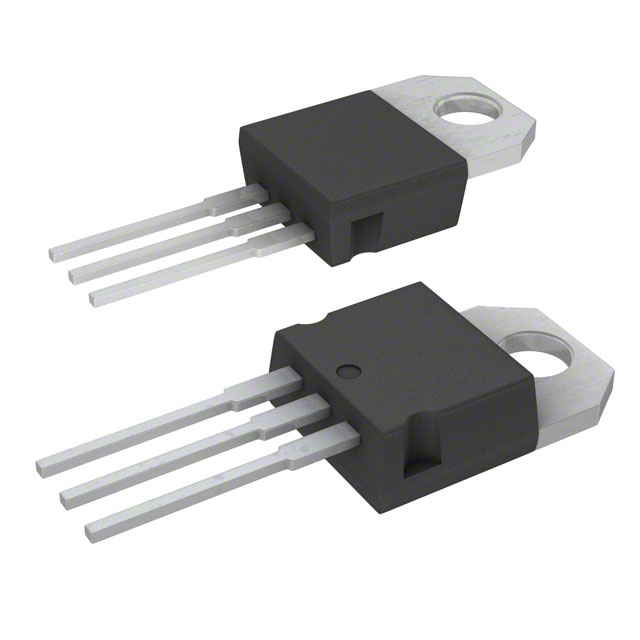Viz Specifikace pro podrobnosti o produktu.

BTA12-800BWRG
Introduction
The BTA12-800BWRG is a solid-state device belonging to the category of triacs. It is commonly used for controlling alternating current in various applications. This entry provides an overview of the basic information, specifications, pin configuration, functional features, advantages and disadvantages, working principles, application field plans, and alternative models of the BTA12-800BWRG.
Basic Information Overview
- Category: Triac
- Use: AC power control
- Characteristics: High voltage capability, high surge current capability, insulated package, sensitive gate
- Package: TO-220AB insulated package
- Essence: Solid-state switching device for AC power control
- Packaging/Quantity: Typically sold individually or in small quantities
Specifications
- Voltage Rating: 800V
- Current Rating: 12A
- Gate Trigger Current: 35mA
- On-State Voltage: 1.7V
- Isolation Voltage: 2500Vrms
- Operating Temperature Range: -40°C to 125°C
Detailed Pin Configuration
The BTA12-800BWRG typically has three pins: 1. Main Terminal 1 (MT1): Connects to one side of the AC load 2. Main Terminal 2 (MT2): Connects to the other side of the AC load 3. Gate (G): Controls the triggering of the triac
Functional Features
- Sensitive Gate: Allows for precise control of the triac
- High Surge Current Capability: Suitable for applications with high inrush currents
- Isolated Package: Enhances safety and reliability
- High Voltage Capability: Can handle high voltage levels effectively
Advantages and Disadvantages
Advantages
- Precise AC power control
- High surge current capability
- Enhanced safety due to isolated package
- Suitable for high voltage applications
Disadvantages
- Sensitive to voltage transients
- Requires careful consideration of heat dissipation in high-current applications
Working Principles
The BTA12-800BWRG operates by allowing controlled conduction of current in both directions when triggered by the gate signal. It turns on when the gate current exceeds the trigger threshold and turns off during the natural zero-crossing of the AC waveform.
Detailed Application Field Plans
The BTA12-800BWRG finds extensive use in various applications, including: - Dimmer circuits - Motor speed control - Heating control systems - Lighting control - Power tools
Detailed and Complete Alternative Models
Some alternative models to the BTA12-800BWRG include: - BTA12-600BWRG - BTA16-800BWRG - TIC226D
In conclusion, the BTA12-800BWRG is a versatile triac suitable for a wide range of AC power control applications. Its high voltage capability, surge current handling, and sensitive gate make it a valuable component in numerous electronic systems.
[Word Count: 411]
Seznam 10 běžných otázek a odpovědí souvisejících s aplikací BTA12-800BWRG v technických řešeních
What is BTA12-800BWRG?
- BTA12-800BWRG is a 12A, 800V, insulated standard triac designed for general purpose AC switching and can be used as an on/off function in applications such as static relays, heating regulation, induction motor starting circuits, and small motor control.
What are the key features of BTA12-800BWRG?
- The key features include high current capability, low holding current for improved noise immunity, and planar passivated for voltage ruggedness and reliability.
In what technical solutions can BTA12-800BWRG be applied?
- BTA12-800BWRG can be applied in various technical solutions such as light dimmers, motor speed controllers, temperature control systems, and solid-state relays.
What is the maximum operating temperature for BTA12-800BWRG?
- The maximum operating temperature for BTA12-800BWRG is 125°C.
What is the typical gate trigger current for BTA12-800BWRG?
- The typical gate trigger current for BTA12-800BWRG is 35mA.
Can BTA12-800BWRG be used in high-voltage applications?
- Yes, BTA12-800BWRG is designed for high-voltage applications with its 800V rating.
What are the recommended heatsinking requirements for BTA12-800BWRG?
- It is recommended to use proper heatsinking to ensure the junction temperature does not exceed the maximum operating temperature of 125°C.
Is BTA12-800BWRG suitable for AC or DC applications?
- BTA12-800BWRG is specifically designed for AC applications and should not be used in DC circuits.
What are the typical applications where BTA12-800BWRG is commonly used?
- BTA12-800BWRG is commonly used in applications such as home appliances, industrial automation, lighting controls, and power tools.
Are there any special considerations when designing with BTA12-800BWRG?
- Designers should consider the thermal management, gate triggering circuitry, and isolation requirements when integrating BTA12-800BWRG into their technical solutions.

